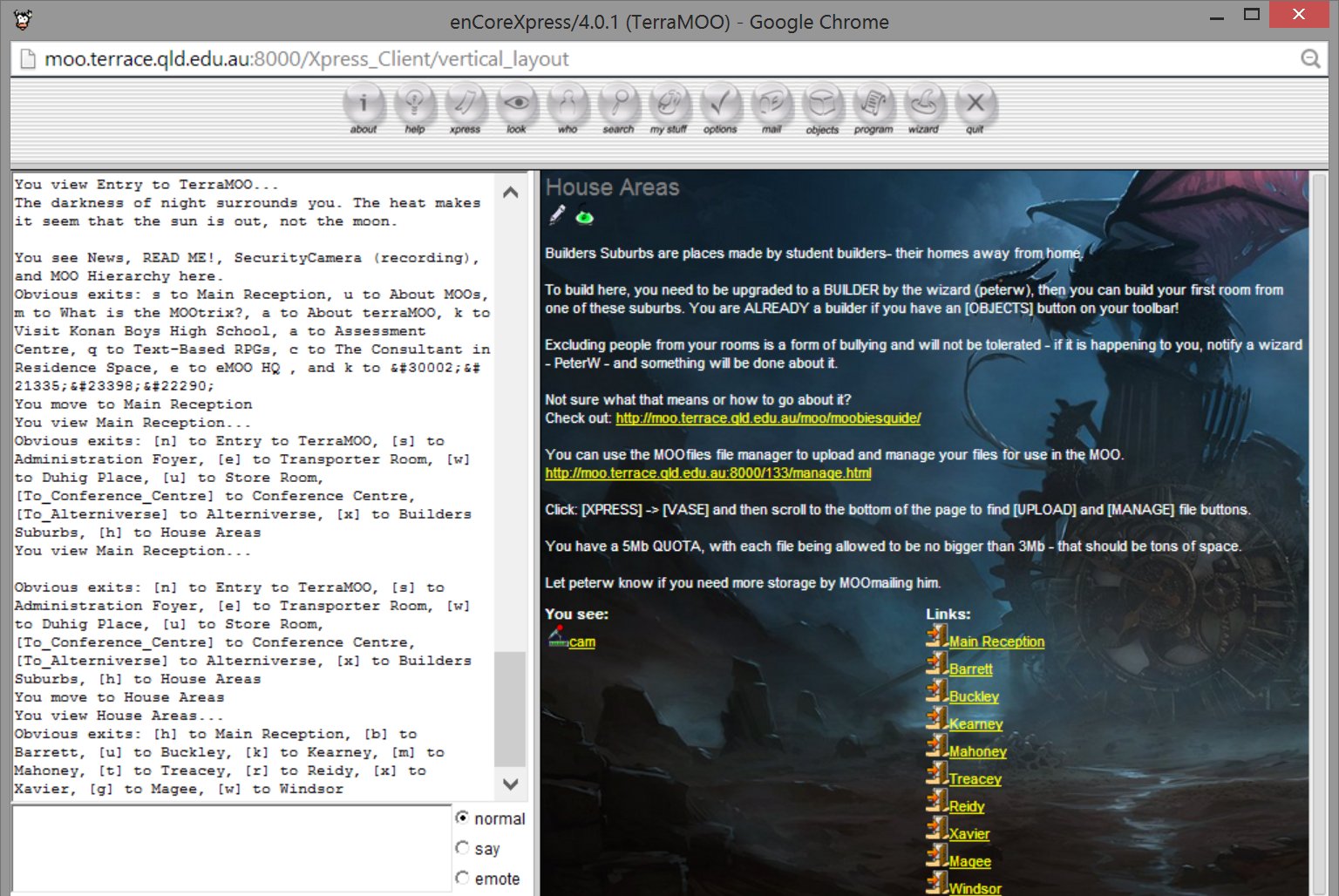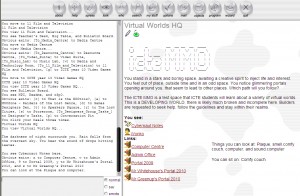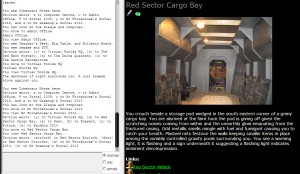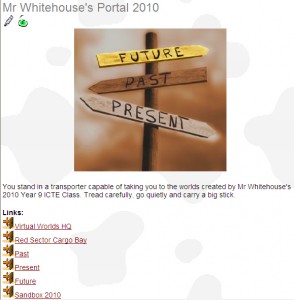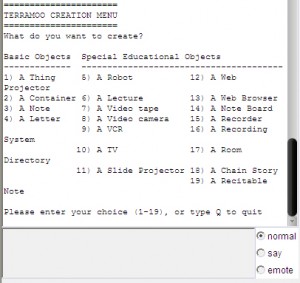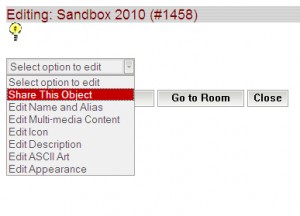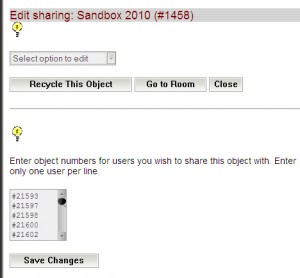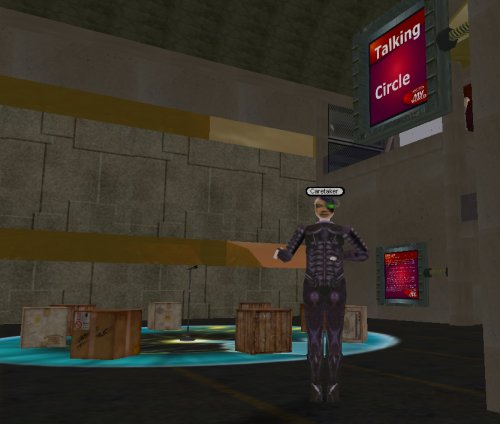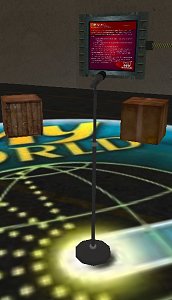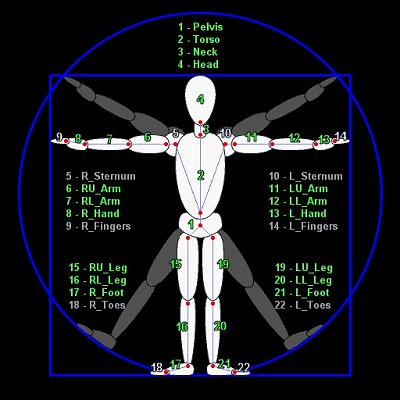Hello Old Friend
After discussion, it was decided to host the first term of our Year 8 Digital Technologies in our MOO (Multi-user Object Oriented learning environment).
There are so many aspects of “digital citizenship” that see so completely and natively at home in a virtual world that the opportunity seemed too good to pass up.
Our MOO has been running, uninterrupted since September 9, 2001, with students first making their way on 14th of that month – a calm safe place to learn just when the world changed so fundamentally.
MOO architecture is based around “room” objects, connected via “exit” objects, embellished with smart objects. Traditionally, using simple menu-based interfaces, kids make.
Knowing a lot about the language underneath, making areas is much faster if it is scripted.
With some simple scripting build commands, a whole new suburb is born, ready for kids to build from
So nice to see stuff happen so fast, will be interesting to see how our 8’s cope with a constructivist, constructionist mentality. Lots still to plan, should be fun.
MOOving on up…
…so I was starting this unit on Virtual Worlds with my year 9 ICTE kids, and we will be investigating all sorts of worlds. One of my favourite is a browser world called a MOO
Multi-user Object Orientated VWs are fairly old-school, but none the less relevent in my opinion. In building the HQ for what will be nearly a Term worth of work, I realised how elegant and RAPID the development of a sense of space is in a MOO
With pictures and words, the sense of place is easily created and added to, we do not need to access object yards, install memory hungry clients, yet we have engaging worlds full of things for kids to do.
With some simple geographical navigation, students travel to a crossroads, make a decision (they are telling a story by establishing a narrative-based scenario) on time period, they they start to plan … I like it that good virtual worlds give you a sense of travelling, that you move from place to place – our MOO is HUGE – tens of thousands of rooms – most made by students, you can literally explore for days.
…there are LOTS of building tools in a MOO – I prefer the command line approach, but there are menu-driven alternatives also, for those that like to click on stuff. Once they have made a thing, they customise it:
Simple menu choices that are consistent across all sorts of objects (there are some differences, depending on the capabilities of an object), and command-line equivalents that are faster – I tend to script most things – with a single paste of a chunk of text, I can make, describe and populate an entire suburb (cluster of interconnected rooms) in a MOO.
I like it that a MOO is built for collaborating, synchronous chat, tools for mediating that are central, tools that work with many using them, implicit sharing or resources amongst teams so they all can contribute
We will be going even “nerdier” in this unit, exposing kids to pure text-based MUDs and some work in an OpenSIM (a second life clone) – few of them can compare with the elegant effective simplicity of a MOO in my considered … it is a pity most people have abandoned them for stuff that is 3D, thinking that if it looks better, it must be better.
I have said this in other forums, but I think it is worth repeating: The amount fo time invested per unit of believable detail is LOWEST in a MOO, HIGHEST in a 3D world.
Do we have the time? – no, that is why we contract others to do the work.
Is it MORE effective? – I am yet to be convinced
say hi to your mum for me 😛
If you can’t talk about it, click on it …
One issue in a multi-user environment is effective communication, particularly when there is a plethora of media through which you can communicate – buth synchronously and asynchronously.
Activeworlds (well, MyWorld at least) is VOIP enabled – so punters can speak to each other physically, while their avatars congregate virtually – quite neat actually.
So I decided to see if I could get a seating arrangement I have heard called a “conversation circle” working. A circle of crates makes sense in this location, turned into seats (well, user-controlled movers with movement disables, and a sit sequence applied to the activate event, controlled xyz displacement so most avatars seem to rest their sitting bums on the top surface naturally) and we have a campfire circle.
Controlling the flow of ideas is sometimes desireable, so I decided to use what has been explained to me as an indigenous idea of handing a “totem” to the talker, whilst every one else listens respectfully. This is, in essence, a “token-ring” mediated conversations [any real geek out there will get what I mean, it is a network flow control strategy for managing overlapping messages]
I wracked my puny brain for something that would naturally work as the “talking stick” and decided that a microphone stand makes perfect sense, in a rock and roll sort of way.
…so I made one, made it a “pick up item” mover and linked it to the left hand of whosoever clicks on it. I adjusted it’s angle when held slightly (so you feel like a rockstar leaning into the mike) and I think this will work. I put down a high-tech rug to give a sense of space and inclusion… fairly happy with the result.
All that is left is to see if it needs a “cone of silence” zone object around it to isolate the chat to just the local area – will know when it is tested what the range of the discussion is in-world.
Attaching objects to parts of an avatar seems to work quite well [remember the hats, see previous post] – avatar body locations can not however assume to all be there on every avatar – if you try to attach to, say, the fingers of a hand and that avatar has no finer articulation, then the linking gets confused, the world panics and sticks the object to your pelvis instead … which can result in much hilarity
In truth, I miss the sophistication of chat mediation tools in something like a MOO, where you have moderation rights, speaker roles and conversation recorders … must explore what is available here also.
Mud Puddling
…now I had this idea for a unit, taught at Year 9 level, involving students creating a virtual environment. It was part 3D, part Browser-world, and mostly in a text-only world. Their task was [I thought] fairly simple: design and make a place, embed a narrative so you have a sense of being there.
Text only? Surely those things have not existed since the mid 90’s, when graphical interfaces took hold?
After wrestling with an odd command set, and a partially hacked version of a Mordor MUD [a textiverse], allowing “builder” class players to construct objects, creatures and feature rooms, groups set about imagining an alternative reality.
The design spec was fairly open-ended [I was determined not to hold those motivated back]: at least 25 rooms, 5 objects and 3 creatures – could be set in past, present, future, could represent fact, fiction or anywhere in-between. Each room had to be described – 5 lines of text minimum [a juicy paragraph describing what it was like to be there]. Once they had done this, they had to echo this textiverse in a browser-based, multimedia capable MOO with the aim of getting them to reflect on the effects of interface on the quality of the experience.
The results astounded me. Honestly.
Year 9s usually hate English, more specifically, they go through a sort of larval stage where a grunt is considered an extended conversation, writing is not something they do [except on their mobile phone]. One group wrote a 45 page planning document, 38 of which were room descriptions – 10pt Courier New … do the maths. Some groups did a good job, most were extraordinary in their writing. Rich, interesting, narrative-laden descriptions, character-based non-linear fiction that you could get lost in. I meddled in the middle, helped them out with the obscure command set, fixed stuff that went pearshaped but the effort and work was theirs. They brought their friends in to see what they had written.
This is new to me, and I like it. Year 9 kids getting so involved with creative writing and constructionist/constructivist learning that they were in during lesson, chose to continue before school, lunchtimes and in the evenings making stuff, trying things, crafting. It was not even like I spent a whole lot of time with the command set, just gave them the basics and wrote a reasonable reference book with some exemplar code and left them to it.
Some struggled with the game-place divide, and had difficulty just describing the place [they had the full set of building tools, so could craft weapons, armour, monsters and rewards] and I sort of let them play, realising that it takes a level of maturity to conceive pure narrative space in what was essentially a game environment, but wow – no, I mean WOW. Some randomly picked rooms from the hundreds made include:
a cruise-ship journey from hell:
Reception
You look around and your eyes are drawn to the lion’s head on the wall that takes away from the free mints on the counter. The timber flooring is wet. It looks like there are wet footprints coming from the south. The curved desk with a glass finish and wooden vinyl façade makes you feel like this cruise has blown your budget big time. But before you take a handful of mints and go steal some shampoo from your shower, a tuscan flower in a blue vase takes your mind off your financial difficulties. The floor tiles match together to make a snowflake. The scent from the flower smells like a cheap cologne. You can hear the buzzing of a fax from behind the desk. There is a painting on the wall which cost more than your house. The tiles look so expensive that you don’t want to stand on them and a marble arch reaches up to the ceiling making you feel small there is some computer equipment sitting on the desk that looks out dated compared to the rest of the room. To a give some extra flavor there a 55 inch LCD TV mounted on the wall. The TV, instead of showing the Rugby, shows a map of the globe and how far you are on your journey so far and how much longer before you hit dry land. The TV is lacking speakers but there is music playing from a radio that adds to the experience.
… a journey in time:
Inside a Worn Time Capsule
You stand still for few minutes before realizing that something has happened to you and your surroundings. You had walked through the door, yes, but.. Why were you in the same room? You closely examine the room that you are in, and you realize what has happened. The machines that were once buzzing and active are now in disuse – the casings have rusted, and the buttons and over half of the levers are either missing or broken. You.. have travelled into the future. The question you ask yourself is why you were the test subject for such an experiment? Were you sent here for a certain purpose? Is there.. a task ahead?
or a street market from a dystopian future:
Market
You stand amidst the northern part of a big market where trading, selling and buying takes place. The owners of the different shops are calling out and trying to attract more customers, while everyone else is talking extremely loud at each other. All sorts of people can be seen here, including doctors, businessmen, tourists, government officials, beggars and much more. You see scrambled rows and columns of shops and stores of varying sizes being set up here that sell assorted types of food, such as veggies, red meat, seafood, canned food, sweets, frozen food, and much more, and the mixed smell of all these food is making this area fairly unpleasant. Stores seem to be competing with each other, as they are paying close attention to each other’s prices and lowering their own, which in the end is good for the consumer. There appears to be a narrow pathway between two of the stores, but you are unsure where it leads to. The market continues south from here, and the exit onto Bails Street can be seen to the south-east.
I learnt a lot from this exercise. Most importantly, I learnt that students will engage if they have some control over what they are making, when they understand the guidelines and personally engage in the task. The enthusiasm and non-verbals from the teacher is also an important factor – assume they will have difficulty and guess what – they will. Tell them it is “hard” and guess what – they will struggle with it.
Catching the Wave
Having time to play is a rare thing, so when my Wave subscription arrived, naturally it arrived in the most inopportune time – dang nab in the middle of marking.
Having a procrastination capacity like no other, I put aside all the things I was supposed to be doing to play with Wave and it struck me as familiar. No, I have never seen a tool like it, but underneath, the platform reminded me of something I have been using for years.
Each wave is like a room, in that it has a sense of place – somewhere you can go. You can invite people to visit and contribute via rich media tools and if you arrive late, you can replay those interactions to see what has gone on before. Wave participants can add or use existing smart objects (widgets, gadgets, thingies) in the wave, and they can build connections between waves.
This synchronous room-based architecture is not new, this sort of multi-user virtual environment (MUVE) has been around since the early 90’s – back then it was called a MOO. From what I can glean, wave is a modern incarnation of one. This is evidenced by the number of RPGers, MMOers and non-linear story tellers who have rushed to use it as a companion (or indeed a platform for their passion).
Comparing it to a MOO is not a derogatory remark, actually it is high praise indeed – MOOs are constructionist, constructivist collaborative powerhouses that offer education immense benefits – will Wave be as successful? I guess it depends on a few things. Stability of the cloud it works in, availability to the general masses, ability to control griefers, the growing toolbox of smart objects that can be used in a wave and education of users on how to use it.
There’s the rub – a powerful tool should not be confusing but wave initially confuses and the examples and interactive help dumb-down the potential making prospective users think it is merely a modern incarnation of email when it actually has the potential to be so much more.
I look forward to development and general adoption, interesting times ahead.

